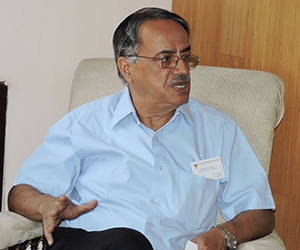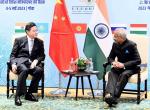As part of ongoing efforts to further strengthen Indo-Japan relations, Japanese Defence Minister Itsunori Onodera visited India in early January to discuss cementing of military ties. The visit comes close on the heels of China’s declaration of a new Air Defence Identification Zone (ADIZ) over East China Sea which has implications on Japanese sovereignty over Senkaku/Diaoyu islands that are bone of contention between Tokyo and Beijing. India has also been at the receiving end of China’s assertive policies along the disputed Sino-Indian border. In fact, PLA made fresh transgression across the Indian border in Chumar area in the first week of January. Thus both nations have common goals in ensuring that China is restrained from aggressively pursuing its interests at the cost of other nations. While Japan has an alliance with the U.S. to address its security concerns, Tokyo has also been seeking stronger defence relationships with countries like India and others in the Asia-Pacific.
Japan is also in the process of shedding its pacific outlook and is revitalising its defence capabilities. In mid-December 2013, Japan came out with a new National Security Strategy (NSS), a National Defence Programme Guidelines (NDPG) and a much improved Five Year Midterm Defence Programme (2014-18) which indicated that Japan was firmly moving away from its pacifist constitution. In its documents, Japan has expressed concerns over the changing strategic and security environment. Tokyo is strengthening its alliance with the US and has supported America’s rebalance strategy. On the other hand, there is also thinking amongst America’s traditional allies like Japan as to how far the US would go to help them if there is hot conflict with China. Thus, there is a move to strengthen Japanese Self Defence Forces (JSDF) as part of internal balancing. In effect, this would supplement the American capabilities to meet the challenges of Anti Access and Area Denial strategies. And therefore enhancing its defence and security relationship with countries like India and those part of ASEAN are designed to maintain a strategic equilibrium in the region.
Because of convergence of their interests, India, Japan and the U.S are also engaged in trilateral dialogue to work towards peace and stability in the region. In fact, well before the unveiling of the American rebalance strategy, there was a Quadrilateral Security Dialogue initiated between US, India, Japan and Australia in 2007 and a joint naval exercise was also carried out off the shore of Okinawa in that year. Viewed by Beijing as some sort of a concert of powers being formed against China, the level and scope of the joint exercise invited a diplomatic demarche from the PRC. Australia under pressure disassociated itself from the initiative. But later Australia has corrected its policy and seems to be aligning again with the U.S. and Japan. India had clarified its position that the exercises were not designed against any country and has been following some kind of a middle path since then.
Besides strengthening its alliance with the US, Japanese security strategy talks about ‘strengthening cooperative relations with countries with which it shares universal values and strategic interests such as Republic of Korea, Australia, the countries of ASEAN and India’. India is considered as being geo-politically very important especially by virtue of its location, its economy and demographic strengths. Strengthening bilateral relations with India in a broad range of areas including maritime security is one of the cornerstones of the Japanese new defence strategy. It also talks about strengthening trilateral frameworks like Japan-US-India grouping.
Japan’s new NSS indicates that in its efforts of ‘Proactive Contribution to Peace’, it is willing to participate in joint development and production of defence equipment and other related items. Clarifying some of its earlier reservations on the issue, the NDPG states “While giving due consideration to the roles that the three Principles on Arms Exports and their related policy guidelines have played so far, the Government of Japan will set out clear principles on the overseas transfer of arms and military technology, which fit the new security environment.” This in effect means that Japan would be ready to export weapons if it contributes to peace. Evidently, this new guideline is a major departure from the policies it pursued till now. This aspect is very important from the Indian point of view as relaxing of curbs on exports of defence technology and weapons and possibilities of joint development in defence industry would offer tremendous potential for Indo-Japanese defence cooperation which could be strategically and economically beneficial to both sides.
Japan’s midterm defence plan caters for over 240 billion US dollars to be spent over next five years which would largely add to its air and naval capabilities as also would go towards improving the cutting edge of its land forces. Enhancing its military capabilities is obviously being done as a response to the increasingly aggressive behaviour of China in recent times. The Japanese defence budget during its defence plan period is of course much more than India’s likely defence budget for the next five years but less than what China is expected to spend in the same period. Acquiring improved intelligence, surveillance, and reconnaissance capabilities besides a robust command, control and information networks would be essential elements of modernisation of JSDF.
Cyberspace and outer space have been considered as two vital areas where JSDF’s response and capabilities would be strengthened. China has been very active in cyber space wherein besides some other nations India and Japan have been at the receiving end of cyber attacks originating from China. However, mission definition of JSDF in case of a cyber attack is very limited and has not been well defined; for instance, the military is not charged with responding to cyber attacks on critical national infrastructures like in other countries. Further, PLA’s anti-satellite capabilities not only make US satellite networks vulnerable they also pose a challenge to Indian and Japanese space assets. Though India already has an ongoing cyber security dialogue with Japan as part of 2+2 framework which includes a Foreign Secretary level Dialogue and the Defence Policy Dialogue, there is a need for India to expand its engagement with Japan for exchange of cyber and space technologies to address mutual security concerns.
India has been looking forward to acquiring ShinMaywa US-2i amphibian aircraft for the Navy to strengthen its naval aviation arm. In fact, during Prime Minister Manmohan Singh’s visit to Japan in May 2013, a Joint Working Group to explore the modalities for cooperation on the US-2 amphibian aircraft had been established. It needs to be remembered that Japan has a well-developed fighter aircraft production and technological base. The last F-2 aircraft was delivered to JSDF in 2011 but the capabilities available can be exploited for joint production development and export. Provided that possible Japanese reservations could be overcome based on the new NDPG, India should explore cooperation in this area. So far Japan has been keen to sell the aircraft to India but as indicated to Japan during a Joint Working Group Meeting in December 2013, New Delhi is keen to manufacture the aircraft jointly. Further, there is considerable scope for joint research development in high end technologies in both civil and military arena.
In addition, for the first time, a bilateral Joint Naval exercise between the Indian Navy and Japan’s Maritime Self Defence Force was carried out in June 2012 off the coast of Japan. And another joint naval exercise was carried out in Bay of Bengal in December 2013. Increasing frequency of joint naval and maritime exercises is part of the Japan’s NDPG and strategic outlook. Even the Coast Guards of the two countries have been carrying out joint exercises to improve interoperability and address security challenges to maritime security. These areas of defence cooperation were further discussed during Itsunori Onodera’s visit. India supports the principle of freedom of navigation though the seas and cannot but be in agreement with the principle espoused by Onodera that “no country should unilaterally change the status quo”.
Since 2008 when the joint declaration between Japan and India on defence and security cooperation was signed, the strategic relationship has grown multifold. In end November and beginning December 2013, Emperor Akihito and Empress Michiko visited India signifying the close relationship between India and Japan. Defence Minister Itsunori Onodera visit is a precursor to Japanese Prime Minister Shinzo Abe’s coming visit to India as a Chief Guest for the Republic Day parade on January 26, 2014. Both India and Japan share the same democratic values and common political, economic and security concerns. Japan’s new thinking on defence issues provides a stronger platform for India and Japan to pursue their common strategic interests.
Published Date: 20th January 2014, Image source: http://1.bp.blogspot.com










Post new comment